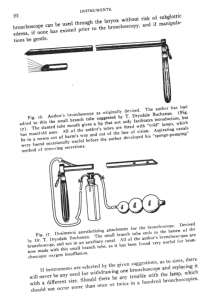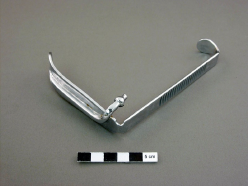
Explore This Issue
ACEP Now: Vol 36 – No 10 – October 2017(click for larger image)
Dr. Chevalier Jackson‘s drawings of his 1915 bronchoscope
IMAGE: Jackson C. Peroral Endoscopy and Laryngeal Surgery. 1915.
It was a simple idea that actually has a long-standing history in medicine: Oxygen insufflated into the lungs can prevent desaturation, even without ventilation. This phenomenon, proven by M. Jack Frumin, MD, as early as 1959, is a product of the difference in gas solubility between oxygen and carbon dioxide. During apnea, CO2 diffuses passively out from the lungs at only 10 mL/minute, but the engine of hemoglobin absorption across the capillary bed absorbs oxygen at 250 mL/minute, assuming sufficient open alveoli, an oxygen gradient, and adequate hemoglobin are all present.
Even before apneic oxygenation was physiologically studied, Chevalier Jackson, MD, used oxygen insufflation in bronchoscopic surgery in the early 1900s (see Figure 1). Apneic oxygenation via a bronchoscope remains a standard practice during modern lung surgery. In the 1940s, the Boyle Davis gag (a tongue retractor used for tonsillectomy that inspired Robert Macintosh, MD, to invent the Macintosh blade) had an oxygen port (see Figure 2). In the 1980s, the pediatric Oxiport insufflated oxygen via a small port on a straight laryngoscope blade (see Figure 3).
The first use of nasal oxygen to prolong safe apnea during intubation was by Lynn E. Teller, MD, in 1988, using 3 L via a nasopharyngeal catheter. He demonstrated safe apnea for a period of 10 minutes after the use of muscle relaxants.
History of NO DESAT

The Boyle Davis gag, which inspired the Macintosh blade.
PHOTO: courtesy of Melbourne Museum.
I [Dr. Levitan] attended a meeting of the Society for Airway Management in October 2011, and I heard a lecture describing nasal cannula use to prolong safe apnea during intubation in the morbidly obese. A few days after my return to Philadelphia, I had a patient who was profoundly hypoxic and required rapid sequence intubation (RSI). I put on a nasal cannula, used a bag-valve mask for preoxygenation, and, during the RSI, opened up the nasal cannula. During very prolonged attempts at intubation, the nurse described something that completely amazed me: “Pulse ox 94 … no, 96 … now up to 100 percent!” The readings were increasing despite apnea!
The emergency medicine residents at Thomas Jefferson University in Philadelphia were eager to adopt this new technique, as they quickly realized it meant they were not getting pushed out by the attending during repeat intubation attempts. I also noticed a secondary benefit. When the pulse oximeter was not going down, everyone performed better at intubation.
Pages: 1 2 3 | Single Page





No Responses to “Oxygen Insufflated Into Lungs Can Prevent Desaturation, Aid in Emergency Airway Management”